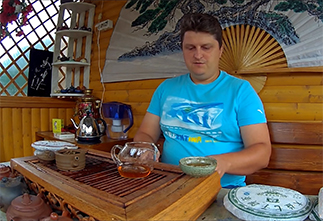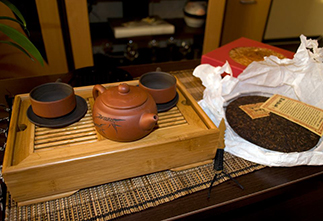-
0 Saturation
-
0 Aftertaste
-
0 Aroma
-
0 Effect
-
0 Balance
-
0 Body
Китайский чай Шу Пуэр 2020 года "Розовое золото" завода "Чжоуши" (周氏, Zhōu shì)
Шу Пуэр 2020 года "Розовое золото" от завода "Чжоуши" — это элитный чай, который сочетает в себе насыщенный вкус, глубокий аромат и уникальную энергетику. Этот чай произведен из отборного сырья, собранного 20 марта 2020 года, и прессован в форму Бин Ча (блин) весом 500 грамм. Название "Розовое золото" подчеркивает изысканность и премиальность этого чая, а его выдержка более 5 лет придает ему особую мягкость и гармоничность.
Особенности завода "Чжоуши"
Завод "Чжоуши" — это известный производитель чая, который славится своим вниманием к качеству сырья и строгим соблюдением традиционных технологий производства. Чай от этого завода отличается насыщенным вкусом, ярким ароматом и сбалансированным характером.
Характеристики чая
Внешний вид
Чайный блин имеет аккуратную форму, характерную для традиционного Бин Ча. Листья равномерно спрессованы, что свидетельствует о высоком качестве обработки. Цвет листьев — темно-коричневый с золотистыми вкраплениями типсов.
Аромат
Сухой чай обладает глубоким, насыщенным ароматом с нотами ореха, древесины, карамели и легкой землистости. После заваривания аромат раскрывается, добавляя оттенки сухофруктов, шоколада и сладковатой пряности.
Вкус
Вкус чая отличается насыщенностью и бархатистостью. Настой имеет насыщенный темно-коричневый цвет с рубиновыми отблесками. Во вкусе преобладают теплые ноты ореха, карамели, сухофруктов и легкой древесной горчинки. Послевкусие долгое, с приятными сладковатыми и пряными оттенками.
Энергетика и воздействие
Шу Пуэр 2020 года обладает согревающим эффектом и способствует расслаблению. Этот чай идеально подходит для холодного времени года, а также для тех, кто ценит спокойное и медитативное чаепитие.
Рекомендации по завариванию
Для заваривания Шу Пуэра 2020 года рекомендуется использовать метод проливов в гайвани или чайнике из исинской глины. Температура воды должна быть около 95–100°C. Первые проливы следует делать короткими (5–10 секунд), чтобы раскрыть аромат и избежать излишней горечи. Постепенно время настаивания можно увеличивать. Чай выдерживает до 8–10 проливов, каждый из которых раскрывает новые грани вкуса.
Шу Пуэр 2020 года "Розовое золото" — это уникальный чай, который сочетает в себе насыщенный вкус, глубокий аромат и богатую энергетику. Его происхождение из провинции Юньнань и использование отборного сырья делают его настоящим сокровищем для ценителей пуэра. Этот чай подарит незабываемые моменты наслаждения и позволит ощутить связь с древними традициями китайского чайного искусства.
Если вы ищете чай, который сможет удивить своей многогранностью и подарить тепло и уют, Шу Пуэр 2020 года "Розовое золото" — это прекрасный выбор.
|
Country
|
China |
|
Manufacturer
|
Чжоуши (周氏) |
|
Raw material production date
|
20.03.2020 |
|
Year of pressing
|
2020 |
|
Pressing form
|
Bing Cha (Cake Tea) |
|
Fermentation method
|
In heaps |
- Reviews
- Vkontakte
The question often arises: how to brew puerh correctly? Sometimes the phrase "to get high" is added to it. Moreover, everyone has their own understanding of this phrase. Some mean vigor, and some - intoxication. So how to brew puerh tea correctly? Let's consider several options.
Traveling through the tea mountains, we found ourselves in another land of blue roofs - the village of Zhongcai, which is located in the Menghai district of Yunnan province. According to tradition, we were shown another local tea tree, which, according to the Chinese, is at least a million years old :) The village is very authentic, not designed for tourists, there are many wild pu-erhs there and, of course, we were warmly received. They treated us to local cuisine and tea. We also asked the residents about the prices of tea and how they have changed in recent years.
The tea ceremony occupies a special place in the centuries-old Eastern tradition. And although the essence of this phenomenon remains constant, the nature and external manifestations of the tea ceremony in different nations have their own national characteristics. In each Chinese province, the tea ceremony and the tea used in it are varied: for example, residents of the southern provinces prefer green tea, and residents of the northern provinces - red tea, in Fujian province they more often use Oolong tea, and in Yunnan province Puer tea is widely known.























































































